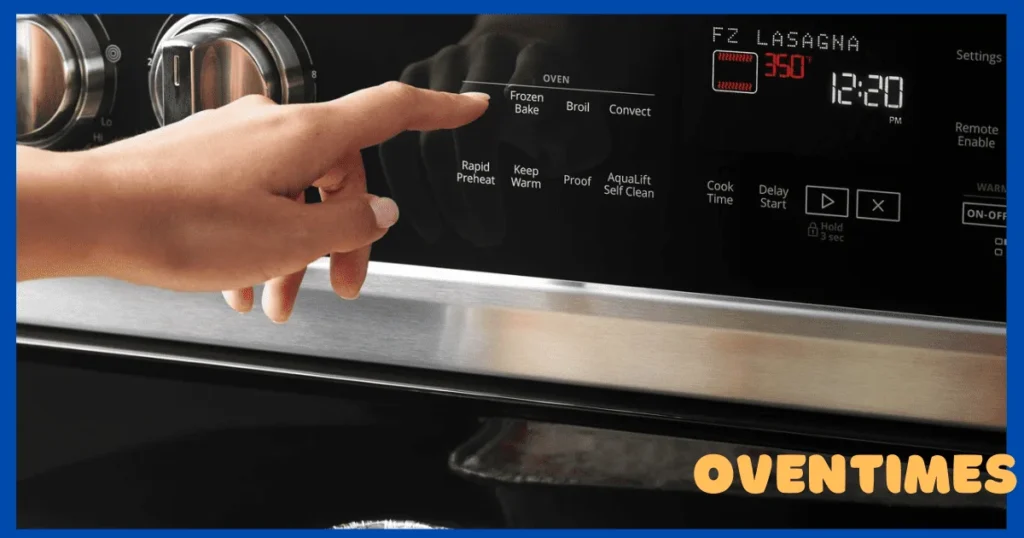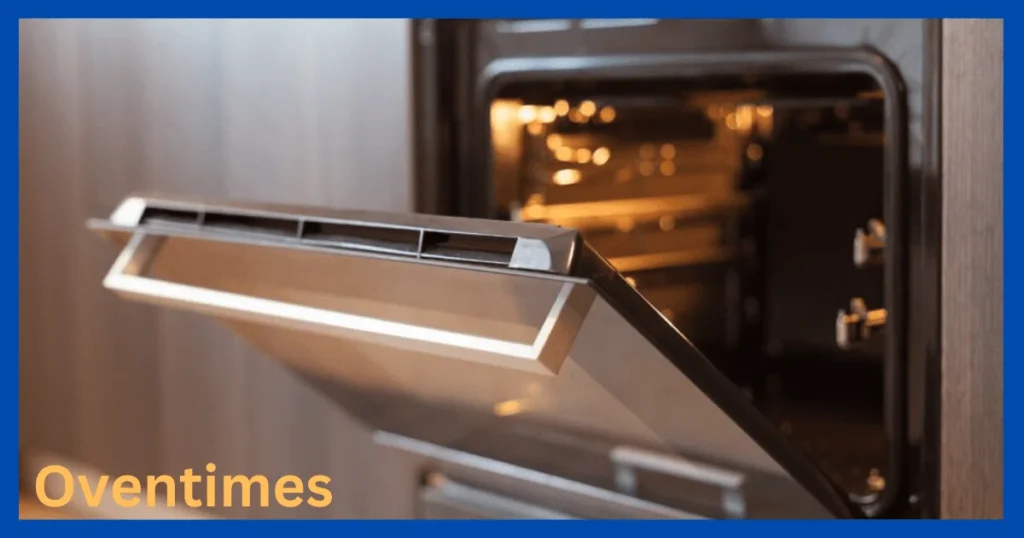Turning off a self-cleaning oven cycle early can have several consequences depending on when and how it is done.
While it is often advised to let the cycle fully complete, there may be valid reasons for wanting to end it sooner. Understanding the self-cleaning process and being prepared can help minimize any potential risks or issues.
Why Would You Want to Turn Off a Self-Cleaning Oven Early?

Here are some common reasons you may want to stop a self-cleaning oven cycle before it is finished:
The Cycle is Taking Too Long
- Self-cleaning cycles can run anywhere from 2-5 hours depending on the oven model. If the cycle seems to be running significantly longer than expected, you may want to turn it off.
Excess Smoke or Odor
- It is normal for some smoke/odor to occur during the cycle. But if it seems excessive, you may want to stop the process.
Concerns Over Energy Use or Electric Bill
- Self-cleaning cycles use very high heat over an extended period, which can impact energy costs. If worried about energy usage, turning it off early may help.
Forgot to Remove Racks or Oven Accessories
- If racks or other items were accidentally left in the oven, stopping the cycle quickly can prevent potential damage to them.
Plans Changed – Oven is Needed For Cooking
- If you suddenly need the oven for cooking but a self-clean is still underway, turning it off early makes the oven usable again sooner.
Safety Concerns
- If anything seems abnormal or you smell gas, stopping the cycle immediately can help avoid potential safety hazards.
What are the Potential Risks of Stopping a Self-Cleaning Oven Early?
While it may be tempting to halt a self-cleaning cycle before it finishes, this does come with some possible risks and downsides to keep in mind:
Residue or Debris May Remain
- Since the high heat cycle was not able to complete, there may be leftover dirt, grease or debris in the oven. This can lead to smoker or odors when cooking afterwards.
Oven May Not Reach Desired Sterilization Temperature
- Part of the self-cleaning function is to burn off bacteria and germs. Stopping it early may prevent it from reaching the fullest sterilization potential.
Locked Door May Not Unlock Immediately
- For safety, most oven doors lock automatically when the self-clean cycle starts. If stopped early, the door lock may not disengage right away.
Higher Energy/Electricity Usage Overall
- If residue remains and you need to run another self-clean after stopping the first one early, it ends up using more energy in the long run.
Oven Components May Get Partially Damaged
- The high heat can damage racks, probes or other items if not given the full cycle to gradually cool down. Thermal shock from stopping suddenly can impact internal oven parts.
Incomplete Elimination of Odors or Smoke
- Lingering food smells may remain in the oven since the cycle did not fully complete and reach max temperature throughout.
Need to Re-Run Another Self-Cleaning Cycle
- If not cleaned sufficiently the first time, another full cycle will need to be run to properly clean and sterilize the oven after stopping the first one early.
What Happens if You Accidentally Turn Off the Oven During Self-Clean?

Accidentally turning off the oven during a self-clean cycle is not recommended, but here is what typically happens:
- The oven immediately turns off and begins cooling down.
- If the door was locked, it usually remains locked until the oven has cooled to a safe temperature. This is an important safety feature.
- The interior components like racks may still be extremely hot when the door unlocks. Use caution removing anything.
- Depending on when in the cycle it was stopped, there may be leftover grime or residue inside the oven.
- A “burning” smell may linger since the cycle did not finish fully. This is from food debris that was not burnt away completely.
- The oven lights may not work, as they often get disabled during the cleaning cycle. They typically come back on after the oven is completely cooled down.
- If the oven was very hot when stopped, thermal shock can damage internal components like heating elements. The oven may cease functioning properly afterwards.
- For severely interrupted cycles, the control panel may lock up or become unresponsive, requiring repair service.
The key is being very careful when opening the oven after an incomplete self-clean, as high heat can remain for a while even after it is powered off. Allow ample time for cooling before using the oven again.
How to Safely Turn Off a Self-Cleaning Oven Cycle
If you need to stop a self-cleaning oven early, here are some tips for doing so safely:
- Locate the oven’s circuit breaker and turn it off at the breaker box. This cuts all power.
- Press the “Stop” or “Off” button on the control panel if possible. This starts the cool-down process.
- Allow at least an hour for the oven to cool if it was at high heat levels. The door needs to unlock before opening.
- Use heavy, insulated oven mitts when removing racks or other accessories after an aborted cleaning cycle. Items stay extremely hot.
- Wipe out any ash or residue gently once the oven interior is cool enough. Avoid abrasive scrubbing.
- Run the “fan only” function for 10-15 minutes before using the oven again to clear any lingering odors.
- Call an appliance repair technician if the oven is damaged or does not operate properly after stopping the self-clean cycle early.
Exercising caution and following oven manufacturer recommendations can help, but there are always risks involved when interrupting a self-cleaning cycle before completion. Allowing it to finish is best if possible.
Conclusion
While today’s self-cleaning ovens make routine cleaning much easier, interrupting or stopping a cycle prematurely does come with hazards. The high heat can damage racks, burn out heating elements, and leave behind grease residue if not allowed to fully complete.
Locked oven doors cannot be opened immediately either. Allowing proper cool-down of at least an hour before opening is crucial. Only stop a self-clean cycle early if absolutely necessary, and use extreme caution when dealing with an oven that had its cycle cut short.
Following safety precautions, allowing for gradual cooling, and calling a technician if your oven malfunctions after an incomplete self-clean will help avoid damage or injury. With proper understanding of the risks involved, you can take steps to safely stop the cycle when required.
Frequently Asked Questions
Here are some frequently asked questions given below:
Is it bad to stop a self-cleaning oven mid-cycle?
Stopping a self-cleaning oven before it completes is not recommended. The high heat can damage oven components, leave behind residue, and prevent the full disinfection of the oven interior.
However, there are some circumstances where stopping early may be necessary or preferred. Use caution and allow proper cool-down time if ending a cycle early.
What happens if self-cleaning mode is turned off?
When self-cleaning mode is turned off, the oven immediately starts cooling down. Excessive heat or smoke may linger until the temperature drops.
The door will remain locked until safe levels are reached. Depending on when stopped, grease or debris may remain in the oven. For safest results, allow the full self-cleaning cycle to finish.
Why is my oven door still locked after I stopped the self-clean cycle?
Oven doors are designed to automatically lock when self-cleaning starts for safety reasons, preventing accidental burns.
Once stopped, the high internal temperature keeps the door locked until cool-down is complete, usually an hour or longer.
This is normal and for your protection. Do not try to force the oven door open after stopping a self-clean.
Can self-cleaning cycle damage oven parts if stopped midway?
Yes, the high heat of self-clean can damage oven parts like heating coils, racks, probes if the cycle is interrupted before completing.
The abrupt change in temperature from stopping suddenly can cause thermal cracks in oven components. Letting the cycle finish allows gradual cooling to prevent damage.
Is it safe to open the oven door after stopping a self-clean cycle?
No, the oven interior and contents are likely still extremely hot immediately after stopping self-clean mode. Always allow at least 1-2 hours for cool-down with the door closed before opening, using well-insulated oven mitts to remove racks or accessories afterwards. Proceed cautiously even with proper cool-down time.
